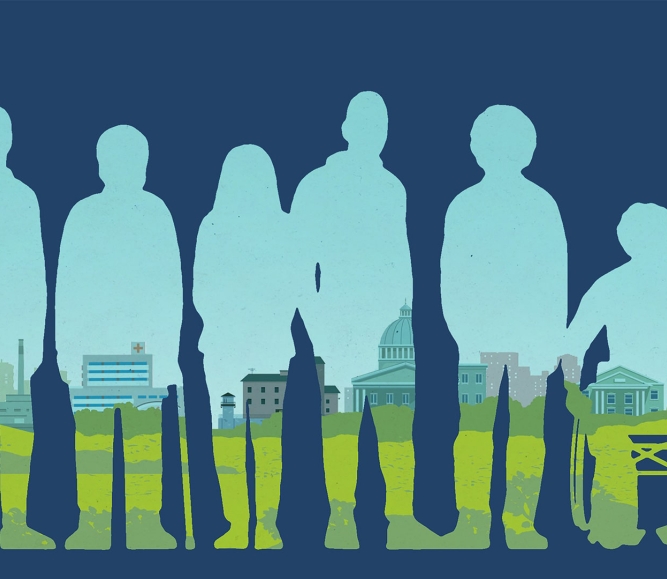Stepping Up: Jamming the Revolving Door

Key Takeaways
The revolving door of jailing the mentally ill is one of the foremost challenges faced by counties across the country, sucking up valuable budgets, time and space, not to mention the toll it takes on mentally ill residents and county employees.
Incarceration has largely replaced hospitalization for thousands of individuals with serious mental illnesses, with county jails holding as many as 10 times more of these individuals than state psychiatric hospitals, according to a report from Public Citizen’s Health Research Group and the Treatment Advocacy Center.
Because those with serious mental illnesses are predisposed to committing minor crimes, experts say, many end up being detained in county jails with limited or no mental health treatment until a state hospital bed becomes available for them, according to the Public Citizen report.
Counties step up to the challenge
A push to reduce the estimated 2 million mentally ill who cycle in and out of county jail cells was started two years ago with the launch of the Stepping Up initiative in May of 2015. Groups leading the effort include NACo, the American Psychiatric Association Foundation and the Council of State Governments’ Justice Center. Stepping Up’s goal is to elevate the issue on a national stage and give counties the resources to attack the problem successfully.
Since it started, the initiative has attracted participation from 350 counties of every size from 43 states. The counties represent 125 million people or 40 percent of the U.S. population. Counties must pass a resolution to be formally recognized as participants in the initiative, as a sign of support in their communities.
Sheriff John Layton of Marion County, Ind., with a population near 1 million, recently told President Donald Trump that 40 percent of his inmates suffer from mental illness, according to a report by The New York Times. The jail dispenses about 700 prescriptions a day and the county spends $8 million a year on care for the mentally ill, the Times reported.
Learn More
Read the Hot Topics report on mental illness and jails
Find out more about the Stepping Up initiative on its Web site
There are glimmers of hope across the country, where counties are moving ahead on programs and seeing results.
In Los Angeles County, the Board of Supervisors voted unanimously in January to double the number of its law enforcement teams that include mental health clinicians. The county began a pilot program in the 1990s and since then, its Department of Mental Health has partnered with 35 law enforcement agencies to develop teams with mental health expertise.
The Sheriff Department’s Mental Evaluation Teams responded to 1,154 calls from July 2015 to July 2016, Supervisor Kathy Barger said. Of those calls, fewer than 1 percent resulted in an arrest, she said. The Los Angeles County Sheriff’s Department has 10 Mental Evaluation Teams and wants to increase that to 23 and also add a “triage desk.”
North of L.A., in Santa Barbara County, the jail saw improvements toward treatment of the mentally ill, after they hired a part-time grievance coordinator. The Sheriff’s Office created a grievance oversight committee made up of activists who communicated with the coordinator. One year into the program, some of the improvements include mentally ill prisoners receiving their needed medications within hours (instead of weeks) and an increase in the number of days a psychiatrist is made available to jail inmates (from three days to five days).
In Montana, Gov. Steve Bullock (D) signed into law a bill putting a Crisis Intervention Team (CIT) training program that trains law enforcement on how to respond to mentally ill people, operated by a nonprofit organization, under governmental control. By putting it under government control, officials can keep track of data to see how effective the training is and open access to additional government funding.
“We’re super excited,” Gallatin County Sheriff’s Sgt. Jim Anderson, executive director of CIT Montana, told the Bozeman Daily Chronicle. “It’s just a great program, and it’s out there to make communities better and help people who suffer from mental illness. It’s the right thing to do.”
In Colorado, the state Legislature is considering a proposal that would support two-person mobile crisis teams, made up of a law officer and a behavioral health specialist, to intervene on mental health-related police calls and de-escalate situations more appropriate for mental health treatment than arrest.
The proposal also calls for expansion of a pre-booking criminal justice diversion program to treat mental illness, as well as additional training for law enforcement and other first responders. They would also expand crisis stabilization centers to make sure they can help people 24/7 and put the centers closer to rural areas.
Some remote counties in Colorado were having to hold the mentally ill in jails because the nearest mental health beds were hundreds of miles away. Under the proposal, mobile crisis units would transport people having a crisis to the closest treatment option.
Stepping Up Attracts Participation from Counties Big and Small
Counties big and small are coming up with solutions — it’s not just a big-city problem, said Nastassia Walsh, NACo program manager, who leads NACo’s Stepping Up effort. “About half of the counties that are participating have populations of less than 100,000.”
Since the program began, counties are at various starting points in implementing their plans to reduce the number of mentally ill in their jails, she said. “Some are just starting from scratch, some have been at it for decades. There is one county that jokes they’re an overnight success, they’ve only been at it for 15 years.”
No matter where your county might be in the process, know that “it takes a lot of time, it takes a lot of effort — there’s no quick Band-Aid for this,” Walsh said.
The work is made easier though with collaboration among counties being carried out by Stepping Up, which makes available resources, networking opportunities and examples of what’s working through its reports, webinars, conferences and Web site.
Launching an Initiative: Six Questions
In January, Stepping Up came out with six questions a county needs to ask as it embarks on implementing a strategy to keep the mentally ill out of jail, providing a jumping off point. Those questions are:
- Is our leadership committed?
- Do we conduct timely screening and assessments?
- Do we have baseline data?
- Have we conducted a comprehensive process and inventory of services for people with mental illnesses who are booked into our jail?
- Have we prioritized policy, practice and funding improvements to connect the appropriate people to the right criminal justice and behavioral health interventions?
- Do we track progress to ultimately ensure successful outcomes for people with mental illnesses who are booked into our jail?
Getting the Word Out, Sharing Ideas
Even “model” counties that find themselves being visited by other counties to check out their programs for keeping the mentally ill out of jail find they “still have a lot of work to do,” Walsh said. And because counties operate in a variety of ways, Stepping Up tries to provide a variety of “best practice” options to fit every scenario. One way they do that is by bringing participating counties together to share ideas.
Stepping Up holds quarterly webinars, focusing on implementing specific strategies, and follow-up phone calls for counties, which are divided into three networks — rural, midsize and large counties. The calls attract county commissioners, county sheriffs and members of county health and human services departments. Only counties that have passed a resolution can take part in the calls.
On the calls, participants share what’s working and also their challenges.
For example, one of the biggest problems counties find is that people who stop taking their medications tend to land in jail over and over again, Walsh noted. One tool some counties are using to solve that problem is starting a peer support program, she said. Peer support specialists are people who have been diagnosed with mental illness but have gone on to live successful lives by staying on their medications.
“They’ve gone through training, it’s almost like a mentorship, but more than that,” Walsh said. A client having problems staying on meds in the program can see that the other person, the peer support specialist, is doing well — “holding down a job, a marriage, children and a home — and that could be them if they can stay on their medication.”
One of the barriers to people taking their medications: Some people suffer from anosognosia, Walsh said; the word is Greek, meaning “to not know a disease.” Some people who are mentally ill think they don’t need to take their medication.
The National Alliance of Mental Illness notes that it is a common symptom of certain mental illnesses, affecting 50 percent of people with schizophrenia and 40 percent of people with bipolar disorder. People with anosognosia are placed at increased risk of homelessness or arrest, the Alliance says.
Another big problem for counties is a lack of data. “Once you have the data, you can identify the problems and start to come up with some solutions,” Walsh said. Instead, county officials say they generally know they are seeing more people with mental illness in their jails but most do not have hard numbers to clearly see what’s going on.
The kind of data that counties need to be collecting includes:
- The number of mentally ill admitted to jail.
- The average length of stay for the mentally ill in jail.
- Connection to treatment of mentally ill in jail.
- Rate of recidivism.
Looking Ahead
The next network call for Stepping Up will take place in June. Anyone can ask questions on the calls and Walsh facilitates the conversations. County officials have been very forthcoming on the calls. “They’re not shy about asking questions or sharing information,” she said. “It’s encouraging and that’s exactly why we’re doing these calls.”
In addition to webinars and network calls, Stepping Up also holds workshops at annual conferences, participates in workshops at state associations of counties at their meetings and at a number of states that hold one-day statewide Stepping Up summits. “We’ve been able to get state association staff members together so they can share what’s working,” Walsh said.
Stepping Up held a national two-day summit last year, with 50 counties participating that was livestreamed on the organization’s Web site, and there’s talk of holding another summit in 2018.
Looking ahead, Walsh said that the group anticipates helping counties to collect, analyze and use their own real-time data to identify mentally ill people in their jails, understand why they’re there and for how long, identify linkages to treatment and track progress toward reducing recidivism.
“We continue to seek ideas for tools and resources that we can develop for counties to share concrete and proven strategies,” she said.
The number one question she gets: “‘What are other counties doing? Are there counties like me?’ We want to continue to highlight the great work that is happening in counties,” she said.
Featured Initiative
The Stepping Up Initiative
The Stepping Up Initiative is a data-driven framework that aims to reduce the overincarceration of people with mental illnesses in jails through training, resources, and support that are tailored to local needs.

Related News
Stretching small opioid settlement allocations helps funding do more
States and localities are set to receive $56 billion in opioid settlement dollars over an 18-year period, but not every county that receives settlement funding will get enough to build out infrastructure.



